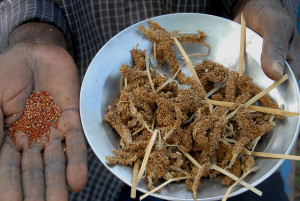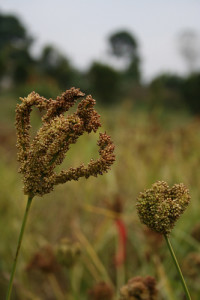Category : News
Published : March 9, 2015 - 10:22 AM
Finger millet (Eleusine coracana) belongs to the Poaceae family and is a species of millet grown in the arid parts of Africa and Asia. Historically, the oldest domesticated sample of this crop dates back roughly 5000 years to a prehistoric site in Ethiopia. The millets, which actually means small seeds contain fantastic characteristics and traits that are adaptable to current and future climate changing conditions, as well as holding good nutritional qualities, essential for food security.
It is a popular crop in dry areas because it is able to survive in areas of low soil fertility and can lie dormant for weeks. Once the much anticipated first rains arrive the crop begins to flourish and is ready for harvesting in just forty-five days. The crop has excellent storage behaviour and can be stored up to two years without pesticide treatment. In areas where farmers lack adequate storage facilities and often have high post-harvest losses these traits are extremely valuable and enables the seeds to act as a reserve during the hunger season. Importantly for farmers is its use in intercropping systems with other favourable crops such as maize, and sorghum. Intercropping in this way allows farmers to benefit from growing two or more crops to generate extra income and increase food security. However, the intensive labour cultivation of the crop and its low resistance to blast disease is one of the drawbacks and has led farmers to favour the production of maize, sorghum and cassava instead.
Despite this fact, the cereal is actually one of the most nutritious of all the worlds cereal crops but the perception of finger millet as a poor-persons crop has had serious health implications. In households where rice has replaced finger millet as the staple diet, nutritional deficiency and anaemia are widespread. It is nutritious because it contains methionine a vital amino acid that is absent from the diets of millions of poor people who survive on starchy and bulky foods such as cassava and plantain. It also contains high levels of starch, calcium and iron and is popular amongst people with diabetes due to its slow digestive breakdown and release of energy. Poor farmers have come to rely heavily on the crop during times of extreme hunger and its nutritionally rich content allows them to keep themselves moderately nourished.
In the kitchen, finger millet is a multi-use ingredient and one of its main uses in Africa is to provide malt to make local beer and other alcoholic and non-alcoholic beverages. For example, areki is a popular Ethiopian liquor produced from finger millet. The grains of finger millet can be ground into a flour to be used in porridge or to make cakes which are then wrapped in maize husks or banana leaves and then roasted. Other flat cakes can also be made by mashing a banana into finger millet flour and frying or baking.
The uses of the millet plant are farther ranging than food from the seed. Medicinally, the seeds are used as a prophylaxis for dysentery, whilst in southern Africa the juice of a mixture of finger millet leaves and leaves of Plumbago zeylanica are taken to relieve the symptoms of leprosy. Straw from the stems makes good material for thatching and plaiting and is used for animal fodder. In China stems are also used for making paper. In Sudan the leaves are made into string. In Uganda by-products of beer are used to feed chickens, pigs and other animals.
The small grains of finger millet and its contribution towards tackling food security and climate change highlights the importance of this traditional crops in the diets of many. Efforts need to be made to reverse the negative perception of finger millet and measures need to be taken to encourage its production. Its reliance as a food security crop highlights the essential work of the Adapting Agriculture to Climate Change project which is supporting national programs to collect, conserve and use finger millet crop wild relatives.
Projects such as ICRISAT and the HOPE project (Harnessing Opportunities for Productivity Enhancement of Sorghum and Millets in Sub-Saharan Africa and South Asia) are carrying out important and valuable work with farmers, researchers and other partners to assist farmers to cultivate nutritious crops including finger millet. The HOPE project has five focus areas including the improvement of varieties, enabling adoption of improved crops, market development, and capacity building and improving the quality of life for rural poor in Sub-Saharan Africa and South Asia. The project is working towards improving yields of finger millet through enabling farmers to grow improved varieties of the crop. For more information on the project visit http://goo.gl/lR4xtV.
Wild crop relatives of finger millet are an important source of genetic diversity which can improve the yield of the crop and provide resistance to diseases, such as blast, which is the most serious disease of finger millet. Some varieties of this wild relative exhibit a high protein content and are nutritionally rich in calcium. The potential of the wild relatives of finger millet to improve the crop is huge. It is important that we collect and conserve these wild relatives so that we can exploit their amazing genetic diversity to take finger millet breeding to its full potential. In Ethiopia and Uganda there are large amounts of genetic diversity of millets that have been left unexploited and assessed for its full genetic potential.
A gap analysis carried out by the Adapting Agriculture to Climate Change project has shown that the wild relatives of finger millet are underrepresented in Seed Banks. This means that we do not have collections of seeds from a number of geographic locations where we know, from herbarium specimens, that the wild relatives of finger millet can be found. The wild relatives of finger millet are amongst the target crops for the Adapting Agriculture to Climate Change, along with wild relatives of faba bean, sorghum, potato and banana.
References and credits
Written and contributed by:
- Danielle Haddad
- Sarah Cody
- Maria Voronstova
- Beentje, H. (2010). The Kew Plant Glossary: an Illustrated Dictionary of Plant Terms. Royal Botanic Gardens, Kew.
- Brink, M. & Belay, G. (2006). Cereals and Pulses: Volume 1 of Plant Resources of Tropical Africa. PROTA.
- Mabberley, D.J. (2008). Mabberleys Plant-book: a Portable Dictionary of Plants, their Classification and Uses. Third edition. Cambridge University Press, Cambridge.
- Royal Botanic Gardens, Kew (2008). Seed Information Database (SID). Version 7.1. Available online (accessed 23 August 2013).
- Clayton, W.D., Vorontsova, M.S., Harman, K.T. and Williamson, H. (2006 onwards). GrassBase The Online World Grass Flora. Available online (accessed 23 August 2013)
- http://hope.icrisat.org/
- https://cgspace.cgiar.org/bitstream/handle/10568/10811/project1_sorghum.pdf?sequence=6


